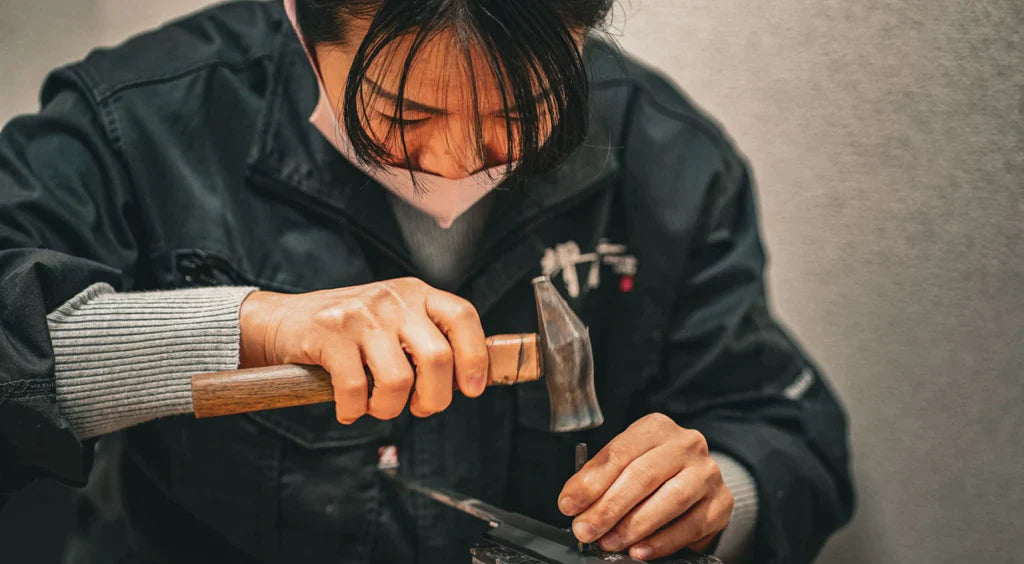
Japanese knives as traditional crafts
Japanese knives are traditional crafts that have cultural value beyond being one-touch cooking utensils .
It has a long history, spanning more than several hundred years, and the artisanal techniques that have been handed down through the ages are still alive today.
Japanese knives are highly regarded by professional chefs around the world for their sharpness, durability and good balance , but beyond that there is a deep culture and values behind them .
The craftsmanship and attention to detail that can be seen during the process, the deep understanding of the materials, and the knowledge that can be passed down through generations make these knives special.
In this chapter, we explore how Japanese knives have established their confidence and the values that underpin them. They are selected to bring richness and joy to the lives of those who use them .
1. Digging deeper into traditional techniques
The traditional techniques of Japanese knife making can be traced back to the Heian period .
During this period, Japanese swordsmiths developed unique forging techniques when crafting swords for the samurai . These techniques were later applied to the production of kitchen knives, and are the source of the sharpness and durability that are unique to Japanese knives.
Knife making involves a huge number of delicate processes, including forging, tempering, and polishing . In forging, the steel is repeatedly worked on to increase its strength and flexibility, and tempering ensures its hardness and sharpness.
In the final sharpening process, the edge is polished by hand by the craftsman, bringing out the knife's inherent beauty and functionality.
These traditional techniques have been passed down from generation to generation through the careful handiwork of artisans and have not lost their value even today.

2. Source of quality
The manufacturing process, which begins with the selection of materials, and the painstaking skills of craftsmen are major contributing factors in the quality of competition knives being highly regarded around the world .
In particular, the quality of the steel used is an important factor in determining the performance of the knife .
Japanese craftsmen carefully craft knives using special steel that can maintain its sharpness for a long time.
Traditional tempering techniques also give the knife the temporary flexibility it needs to achieve the hardness it needs.
Through these processes, the knife is made to be durable and able to maintain its sharpness for a long time .
The high quality of Japanese-made knives is a result of the skills and passion of the craftsmen who go through these processes.

3. Sakai Takayuki: A fusion of tradition and innovation
Sakai Takayuki is a Japanese knife maker with over 600 years of history .
Known for preserving traditional techniques while proactively taking on innovative ideas, Sakai Takayuki makes each knife through a series of processes, starting with the selection of the finest steel, followed by forging, hardening, and polishing by craftsmen.
The brand's distinctive feature is that it offers higher quality knives that meet modern needs by incorporating the latest technology while respecting traditional techniques . In addition to traditional methods, the brand also focuses on developing materials that incorporate the latest scientific knowledge.
This allows Sakai Takayuki knives to continue to offer new value while preserving the traditions of time.
4. Craftsmanship and passion
The skill and passion of the craftsmen who make Japanese knives are important factors in guaranteeing their high quality.
Craftsmen undergo rigorous training over several years to master the traditional techniques of knife making. The knives they make are not just cooking utensils, but have the beauty and functionality to be called works of art. The craftsmen's deep love for their knives and their consideration for the people who use them are alive in each and every knife.
This combination of high skill and passion results in Japanese knives that are loved all over the world.

5. Relationship with the user
Japanese knives are known for building a deep connection with their users.
The more you use these knives, the more they visibly adapt to your cooking style .
What you want from an easy-to-use knife is not just the ability to cut the specified ingredients, but also the ability to increase the enjoyment and satisfaction of cooking .
Japanese knives have earned the deep trust and affection of their users due to their ease of use, balanced weight, and comfort even when used for long periods of time .
In this way, a special relationship exists between the knife and the user that goes beyond that of a one-touch tool.

6. Care and affection
Proper care will help maintain the performance of your Japanese knife for a long time, and it doesn't matter what your relationship with the user is.
By taking care of your knife , such as regular resharpening, careful washing and drying after use, and proper storage , you can keep your knife in top condition . Caring for your knife in this way shows that you care for it, and it also fosters affection and trust in the knife.
The bond with a knife is a direct connection to the user's love for cooking, turning the cooking process into a deeply enriching experience .
A look into the future
Japanese knife-making techniques are respected around the world for their exceptional quality and deep cultural roots.
This tradition will be passed down to the future, with a careful balance between innovation and tradition. As technology evolves, the spirit and skills of the craftsmen are passed on to new generations, and Japanese knives will continue to maintain their confidence .
We hope that this column will offer readers a new perspective on knives and inspire them to rediscover the meaning and value of everyday cooking.
The techniques of knife making and the culture that lies behind them are valuable assets that enrich our lives.













